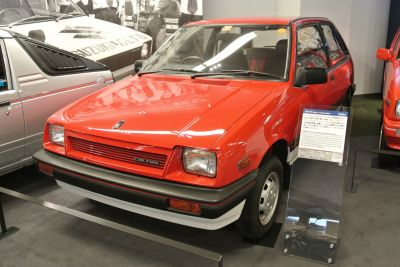 1983 Opel Corsa A Dimensions, Size & Specs
1983 Opel Corsa A Dimensions, Size & SpecsMeasurements of the 1983 Opel Corsa A, engineered for optimal performance and comfort
| Dimensions | |
|---|---|
| Length: | 3622 mm142.6 in11.9 ft |
| Width: | 1532 mm60.3 in5.0 ft |
| Height: | 1365 mm53.7 in4.5 ft |
| Ground Clearance: | 140 mm5.5 in0.5 ft |
| Trunk Capacity: | 270 liter9.5 cu ft |
| Trunk Capacity (Max): | 1060 liter37.4 cu ft |
| Weight Specifications | |
| Curb Weight: | 740-775 kg1631-1709 lbs |
| Maximal permitted Weight: | 1215-1255 kg2679-2767 lbs |
| Tire Specifications | |
| Rims Sizes: | 14-inch rims:
|
| Tire Sizes: |
|
The Opel Corsa A, produced from 1982 to 1987, marked the debut of the Corsa line as a compact and practical hatchback designed for urban and suburban driving. Officially introduced in 1983 as a model year, this first-generation Opel Corsa showcases a length of 3622 mm (142.7 inches), a width of 1532 mm (60.3 inches), and a height of 1365 mm (53.7 inches). These dimensions contribute to its compact footprint, making it easy to maneuver and park in tight city spaces. The ground clearance is 140 mm (5.5 inches), allowing for comfortable driving over uneven roads and mild obstacles typical in urban environments. It rides on rims sized at 5J x 14 or 13, with tire options including 165/65R14, 165/70R13, and 145/70R13, supporting a balance of comfort and handling. The curb weight of the Opel Corsa A ranges from 740 to 775 kg (1631 to 1709 lbs), reflecting its lightweight design which translates into fuel efficiency and agility. Maximum weight varies between 1215 kg and 1255 kg (2679 to 2767 lbs), indicating the vehicle's capacity when fully loaded. On the practicality front, the Corsa A offers a luggage capacity of 270 liters (9.5 cubic feet) with rear seats in use, expanding significantly to 1060 liters (37.4 cubic feet) when rear seats are folded down, highlighting its versatility for carrying cargo or groceries. Overall, the Opel Corsa A stands as a classic example of a well-sized, efficient compact hatchback of the 1980s, combining economic operation with functional interior space ideal for daily commutes and small families.
Discover the standout features that make the 1983 Opel Corsa A a leader in its class
Have a question? Please check our knowledgebase first.
The Opel Corsa A measures 3622 mm (142.6 inches) in length, 1532 mm (60.3 inches) in width, and 1365 mm (53.7 inches) in height. These compact dimensions made it well-suited for urban driving and tight parking spaces during the 1980s. The size contributed to its popularity as a small hatchback that was easy to maneuver and park in crowded city environments while providing a practical footprint for everyday use.
The curb weight of the Opel Corsa A ranges between 740 kg and 775 kg (approximately 1631 to 1709 pounds), depending on configuration and equipment. The maximum permissible weight, which includes passengers, cargo, and fuel, ranges from 1215 to 1255 kg (about 2679 to 2768 pounds). This indicates a lightweight design that helped improve fuel efficiency and handling, important features for a subcompact hatchback designed in the early 1980s.
The Opel Corsa A offers a luggage capacity of 270 liters (approximately 9.5 cubic feet) with the rear seats in their upright position. When the rear seats are folded down, the luggage capacity increases significantly to 1060 liters (about 37.4 cubic feet). This flexibility made the Corsa A practical for carrying larger loads or bulky items, offering versatility unusual for a small hatchback of its era.
The ride height, or ground clearance, of the Opel Corsa A is 140 mm (5.5 inches). This moderate ground clearance was typical for a small hatchback, providing a balanced ride quality and handling characteristics suitable for urban and suburban roads. It was low enough to aid stability and aerodynamics, yet sufficient to clear typical road obstacles without damaging the underside in everyday driving conditions.
The Opel Corsa A was equipped with rims sized primarily at 5J x 14 inches and also at 5J x 13 inches for some variants. Tire sizes included 165/65 R14, 165/70 R13, and 145/70 R13. These tire and rim combinations contributed to the car's agile handling and compact profile, tailored to the needs of city drivers looking for economical yet stable performance.
Yes, the Opel Corsa A fits comfortably into a standard garage. With a length of 3622 mm (142.6 inches), width of 1532 mm (60.3 inches), and a height of 1365 mm (53.7 inches), it is compact enough to allow for ample clearance inside typical residential garages, which usually measure at least 2.4 to 3 meters wide and around 5 to 6 meters deep. This makes it practical for everyday use and storage in urban or suburban home settings.
The Opel Corsa A, launched in 1982 for the 1983 model year, was a fresh entry into the small hatchback segment for Opel, effectively replacing the Opel Kadett C hatchback in the subcompact category. It was smaller, lighter, and more modern in design than many previous Opel models, focusing on economy and urban practicality. Its aerodynamic shape, compact size, and lower weight marked a step forward in efficiency compared to the more boxy, heavier predecessors, appealing to drivers seeking economical transportation during the 1980s.
During its production period from 1982 to 1987, the Opel Corsa A competed with several notable small hatchbacks such as the Volkswagen Polo Mk2, Ford Fiesta Mk2, and Renault 5. Compared to these, the Corsa A was competitive in terms of size and weight, featuring a length of 3622 mm and a curb weight that helped keep fuel consumption low. While perhaps not the most powerful or luxurious, it offered practical dimensions, efficient engines, and versatile luggage space that matched or outperformed rivals in utility and affordability, making it a strong contender in the European small car market.
The Opel Corsa A was designed primarily as a compact hatchback with seating capacity for four to five passengers. The rear bench seat could comfortably accommodate two adults or three children, making it a practical choice for small families or urban commuters. Interior space was optimized given the car’s compact external dimensions, and the foldable rear seats enhanced cargo flexibility by allowing owners to increase luggage capacity from 270 liters to 1060 liters, catering well to both passenger comfort and transport needs.
The Opel Corsa A featured a front independent suspension with MacPherson struts and a rear torsion beam axle setup, common for small front-wheel-drive cars of the era. This setup provided a good balance between ride comfort and handling precision. Due to its relatively low curb weight of around 740-775 kg and compact dimensions, the Corsa A was nimble and easy to maneuver, especially in urban settings. The suspension offered adequate road holding while remaining forgiving on uneven surfaces, making it well-suited for everyday driving needs.
Discover similar sized cars.

| Production: | 1987-1990 |
|---|---|
| Model Year: | 1987 |
| Length: | 3622 mm142.6 in |
| Width: | 1532 mm60.3 in |
| Height: | 1365 mm53.7 in |

| Production: | 1988-1993 |
|---|---|
| Model Year: | 1990 |
| Length: | 3622 mm142.6 in |
| Width: | 1540 mm60.6 in |
| Height: | 1365 mm53.7 in |

| Production: | 1983-1988 |
|---|---|
| Model Year: | 1983 |
| Length: | 3585 mm141.1 in |
| Width: | 1530 mm60.2 in |
| Height: | 1350 mm53.1 in |
